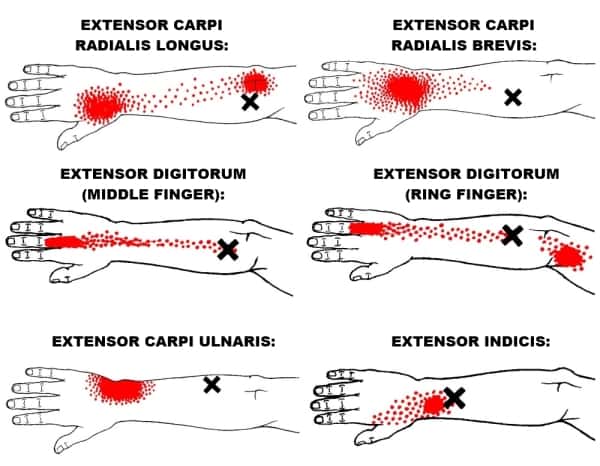The wrist extensors are a group of nine individual muscles on the back of the forearm that act on the wrist and fingers.

Collectively, their primary function is wrist extension, though they also help carry out other movements of the wrist and fingers.
The individual wrist extensor muscles are as follows:
- Extensor carpi radialis longus (ECRL)
- Extensor carpi radialis brevis (ECRB)
- Extensor digitorum (ED)
- Extensor digiti minimi (EDM)
- Extensor carpi ulnaris (ECU)
- Extensor indicis (EI)
- Extensor pollicis longus (EPL)
- Extensor pollicis brevis (EPB)
- Abductor pollicis longus (APL)
All of these muscles belong to the posterior compartment of the forearm, a classification that can be subdivided into superficial and deep layers:
- The ECRL, ECRB, ED, EDM and ECU are classified as part of the superficial posterior compartment of the forearm, which also includes the brachioradialis.
- The EI, EPL, EPB and APL are part of the deep posterior compartment of the forearm, which also includes the supinator.
These muscles originate from different points on the posterior surfaces of the ulna and radius, and on the distal humerus.
Their fibers travel distally, down the back of the forearm, and insert on the back of the carpals, metacarpals and phalanges.
All extensors are parallel-oriented fusiform muscles, except for the extensor digitorum, which has an oblique fiber orientation and a unipennate architecture.
Note: Most sources I found classified the ECRB and ECU as fusiform, but at least one source contradicts that and classes them as bipennate muscles.
Also Called
- Back of the forearm
- Extensor muscles of the forearm
- Finger extensors
Origin, Insertion, Action & Nerve Supply
| Muscle | Origin | Insertion | Action | Nerve Supply |
|---|---|---|---|---|
| Extensor carpi radialis longus (ECRL) | Lateral supracondylar ridge of the humerus | Posterior surface of the base of the 2nd metacarpal |
|
Radial nerve (C6-C7) |
| Extensor carpi radialis brevis (ECRB) | Lateral epicondyle of the humerus via the common extensor tendon | Posterior surface of the base of the 3rd metacarpal | Deep branch of radial nerve (C6-C8) | |
| Extensor digitorum (ED) | Extensor expansions of the index, middle, ring and little fingers |
|
||
| Extensor digiti minimi (EDM) | Extensor expansion of the little finger |
|
||
| Extensor carpi ulnaris (ECU) |
|
Posterior surface of the base of the 5th metacarpal |
|
|
| Extensor indicis (EI) | Distal 1/3 of the posterior surface of the ulna and interosseous membrane of the forearm | Extensor expansion |
|
Posterior interosseous nerve (C6-C8) |
| Extensor pollicis longus (EPL) | Middle 1/3 of the posterior surface of the ulna and interosseous membrane of the forearm | Posterior surface of the base of the distal phalanx of the thumb |
|
Posterior interosseous nerve (C7-C8) |
| Extensor pollicis brevis (EPB) | Distal 1/3 of the posterior surface of the radius and interosseous membrane of the forearm | Posterior surface of the base of the proximal phalanx of thumb |
|
|
| Abductor pollicis longus (APL) |
|
Lateral surface of the base of the 1st metacarpal |
|
Exercises:
Note: The table below includes just the exercises that directly target the wrist extensor muscles.
However, they also get trained indirectly in any exercise where the wrist must resist the weight/gravity to stay in neutral and avoid going into wrist flexion (i.e. any variations of the reverse biceps curl, front raise, lateral raise or rear deltoid raise).
| Type | Name | Picture |
|---|---|---|
| Barbell: |
 Tutorial: N/A
|
|
| Dumbbell: |
 Tutorial: N/A
 Tutorial: N/A
|
|
| Cable: |
 Tutorial: N/A
|
|
| Machine: |
 Tutorial: N/A
 Tutorial: N/A
|
|
| Other: |
 Tutorial: N/A
 Tutorial: N/A
 Tutorial: N/A
 Tutorial: N/A
 Tutorial: N/A
 Tutorial: N/A
 Tutorial: N/A
|
Stretches & Myofascial Release Techniques:
Stretches
| Name | Picture |
|---|---|
 Tutorial: N/A
 Tutorial: N/A
 Tutorial: N/A
|
Self Myofascial Release Techniques
When using these techniques, give special attention to the common trigger points shown in the image below.
| Tool | Picture |
|---|---|
 Tutorial: N/A
 Tutorial: N/A
 Tutorial: N/A
 Tutorial: N/A
|
Common Issues:
- Overactive/Short Wrist Extensors: The wrist extensors can become overactive and short from overuse caused by activities involving repetitive wrist extension and wrist abduction. Examples of such activities include: carpentry, rock climbing, poor backhand technique in tennis, typing with wrists cocked back and using too much volume or intensity on exercises that train the wrist extensors. The tighter the wrist extensors become, the more stress is put on the common extensor tendon.
- Lateral Epicondylitis: Over time, stress on the common extensor tendon from overuse and overactive/short wrist extensors can lead to lateral epicondylitis, better known as tennis elbow. This is a condition characterized by chronic degeneration of the common extensor tendon. Symptoms include pain in the outer elbow region during resisted wrist extension, gripping activities and passive wrist flexion, in addition to reduced wrist extension and grip strength.
Training Notes:
- If your wrist extensors are overactive and short, do the following:
- Reduce the amount of time spent doing any repetitive activities causing wrist extensor overuse.
- If you’re doing a lot of wrist extensor exercises in your weight training program, make sure you’re using light weight.
- Reduce your total training volume on wrist extensor exercises. It is not necessarily desirable to eliminate wrist extension training altogether; high rep wrist extensor training, especially eccentric training, can help if you’re on the verge of developing lateral epicondylitis.
- Make a habit of doing wrist extensor releases/stretches every day, as well as before and after any direct forearm training. It may also be useful to do these techniques before biceps or back training, since these workouts tend to involve a lot of gripping.
- If your wrist flexors are inhibited and excessively lengthened compared to the extensors (which is not always the case) add some wrist flexor training to your program. This will bring balance to the forearm musculature.
- If you have developed lateral epicondylitis, see how to treat tennis elbow (article coming soon).
- If you don’t have any issues with your wrist extensors, but want to build them up and make them stronger, the training advice below will help:
- Start including wrist extensor exercises in your routine. One or two exercises is all you need. I like wrist roller extensions and dumbbell reverse wrist curls.
- Overall, the muscle fiber type of the wrist extensors is slow-twitch dominant. This means they respond better to high rep sets with lighter weight, high training volume and high training frequency. With that in mind, I recommend doing 6-8 sets of wrist extensor exercises for 12-20+ reps per set, twice per week.
- Train the wrist extensors toward the end of your workout, after doing any exercises requiring a strong grip. This way, you avoid fatiguing your forearms and prevent your grip strength from giving out during a heavy compound movement like the deadlift or bench press.
- Stick to the above training guidelines for at least a couple months. Keep going with the same training protocol until your progress dries up. Once this occurs, add 2-4 more sets per workout and/or start training your wrist flexors three times times per week instead of two.
- Don’t neglect the rest of your forearm musculature. This includes your brachioradialis and wrist flexors. Consider the following for these muscles:
- Wrist flexors: Work the wrist flexors the same way you work the wrist extensors (i.e. high reps, high volume and frequency) and combine their training them into the same session.
- Brachioradialis: Unlike the rest of the forearm musculature, the brachioradialis is a fast-twitch dominant muscle. As such, it responds best to heavier weight and lower reps/volume. Start with 3-4 sets of 6-10 reps on brachioradialis exercises (e.g. hammer curl), once or twice per week. Do it on the same day(s) you train biceps. If your routine allows for it, combine wrist extensor/flexor training with brachioradialis/biceps training.
- Be sure to stretch and release the wrist extensors on a regular basis once you start training them, to avoid any potential tendon issues from overuse. Pay attention to how you feel and cut back immediately on volume and frequency if you think you might be stressing the tendons too much.



Nice article and review. Question. I had surgery on my forearm for anterior interosseous nerve entrapment. Presumably because of postoperative scarring, my wrist extension on that side is limited, making cleans etc painful. do you know of a wrist brace that might help? Thank you. fred
Hi Fred, thanks for reading and commenting. I’m happy to hear you enjoyed the article. To answer your question, I would first have to say that I’m not a medical professional, and you should definitely get an okay from your physician or physical therapist before doing anything.
If you still have to be in an actual brace (i.e. a device that restricts range of motion to allow for healing), then you probably shouldn’t be doing cleans at all…
…However, I’m guessing you just mean any type of wrist support. Assuming that’s the case, I know that a lot of guys will use wrist wraps (like these ones) to reduce pain on power cleans/front squats.
Thankfully I’ve never had to deal with wrist issues, but from what I’ve read, the key to wrapping them successfully is get the right position: You don’t want them too high,, since that will impair your range of motion. But you also don’t wan’t them too low, since they won’t really provide any support and therefore won’t reduce pain.
Additionally, or alternatively, you could look into using athletic tape on your wrists. You’ll also have to practice taping your wrists to get the right amount of pain reduction/flexibility.
Again, please consult your doctor/physical therapist before doing either of these solutions. I know how much it sucks to not be able to lift at full capacity, but it’s not worth prolonging your healing time, or possibly re-injuring yourself.